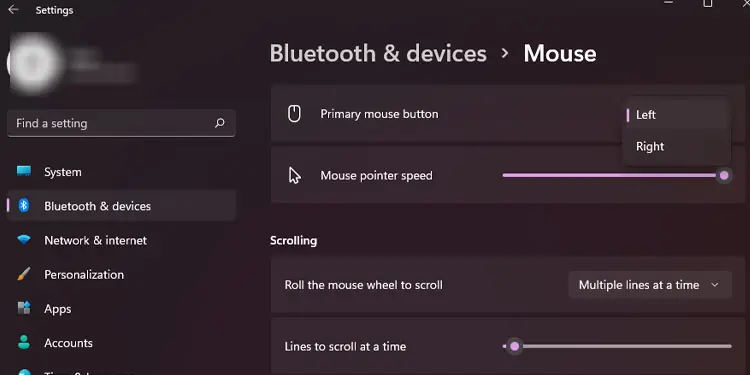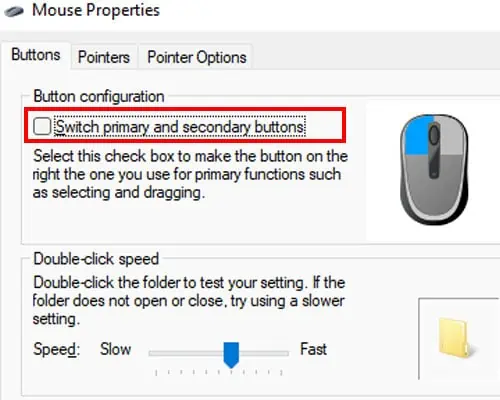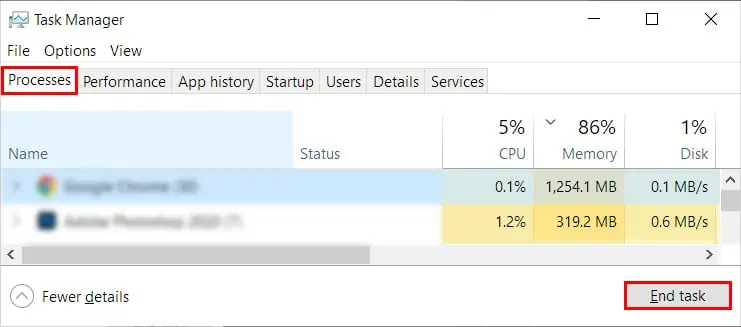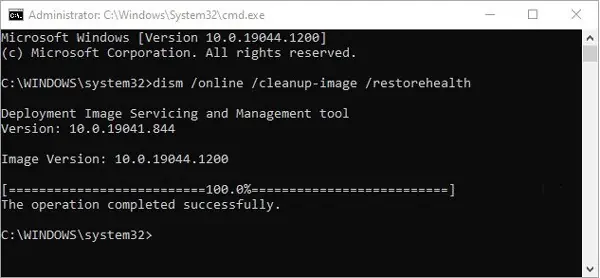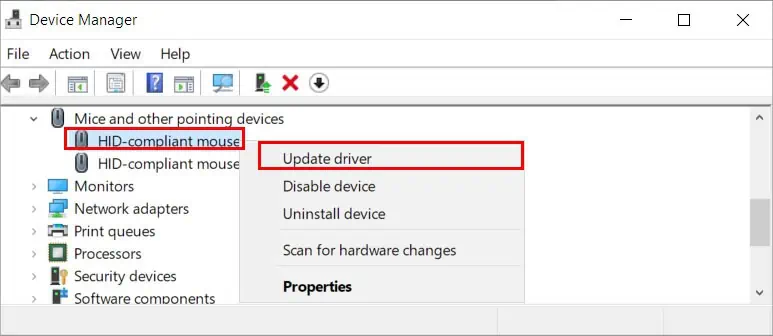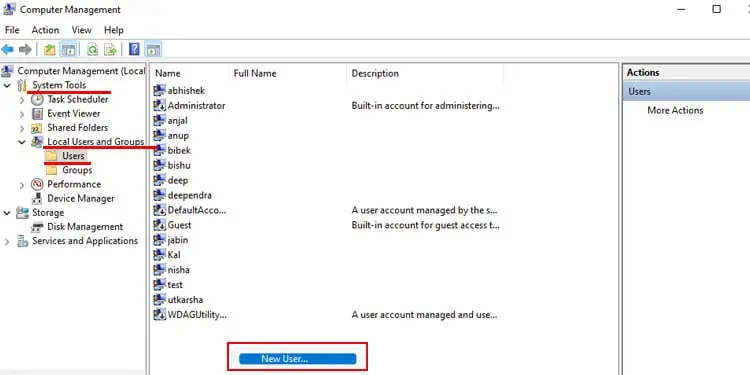A mouse, generally, starts to malfunction when you have a corrupted mouse driver or a faulty mouse itself. However, wrong power settings, issues with the antivirus, or corrupted system files are known to make your mouse malfunction. One of such malfunction is the computer not registering mouse clicks.
In this article, we have listed some reasons your PC doesn’t register mouse clicks and possible solutions to it.
Why Is My Mouse Clicks Not Registering?
Sometimes, a click may not get registered when the CPU suffers from high CPU usage. The entire system will get choppy with a high CPU load, and the mouse cursor may not even respond.
However, this is not the only reason your PC is not registering mouse clicks. Here are a few other reasons for your mouse click not registering.
- improper button mapping
- High CPU usage
- Outdated mouse/USB driver
- Faulty mouse
- USB power saving mode
- Corrupted driver files
How to Fix Mouse Click Not Registering?
If your PC is not registering mouse clicks due to the computer being slow, a simple restart may fix the issue. In case the restart does not fix the issue, please follow the solutions mentioned below.
Change Buttons Configurations
First, let us begin by ensuring that the primary button is set correctly. In some new computers, the primary mouse button will be set to right-click by default.
Change Primary Button
If you use a left mouse button as the primary mouse button and the primary button is set to the right mouse button, it can make you feel like the mouse clicks are not registering.
Follow these settings to change the primary mouse buttons.
- Press the Windows + I key to open Settings.
- Go to Bluetooth & devices > Mouse.
- Set the Primary mouse button to the desired one.

Alternately, you can also follow these steps to switch primary buttons.
- Press the Windows + R key to open Run.
- Type
main.cpland press Enter to open Mouse Properties. - Make sure you are in the Buttons tab.
- Under Button configuration, uncheck Switch primary and secondary buttons to set the left mouse button as primary and check the option if you want the right mouse button as primary.

Adjust Double Click Speed
Your mouse buttons may register when you click once but may not register when you double click. In this case, it can be that the double click speed is set to fast. The computer will not register the second click when double-clicking if the interval between the two clicks is high.
To fix this, you must set the double click speed to slow or medium.
- Press the Windows + R key to open Run.
- Type
main.cpland press Enter to open Mouse Properties. - Make sure you are in the Buttons tab.
- Under Double-click speed, set the Speed to slow.

Lower High CPU usage
CPU on full load will take some time processing new tasks. Therefore, when you click a mouse during high CPU usage, the computer may not register the click at all. To fix this, you need to lower high CPU usage.
You can use the Task Manager to lower high CPU usage.
- Press the Ctrl + Shift + Esc to open Task Manager.
- Click on More details if the Task Manager shows a list of running applications.
- On the Processes tab, look for the CPU row.
- Click on the process that is taking high CPU and select End task.

Disable USB Selective Suspend
When USB ports are not in use, enabling USB Selective Suspend will stop the power to said port. However, when the mouse is not in use, the Operating System may detect the mouse as unused, and it can stop power to the mouse.
Try disabling USB Selective Suspend to see if it fixes the problem with the PC not registering mouse clicks.
- Press the Windows + R key to open Run.
- Type
powercfg.cplto open Power Options. - Click on Change plan settings on the selected power plan.
- Select Change advanced power settings.
- Expand USB settings, and then expand USB selective suspend settings.
- Set it to Disabled.

- Click on Apply, then OK.
Uninstall Recently Installed Application
If your mouse starts to malfunction after installing an application, it can be that this particular application is causing the issue. Although an application likely causes an issue with the hardware, it is not unheard of.
Remove any recently installed application to check if it fixes any complications with the mouse clicks.
- Press the Windows + R key to open Run.
- Type
appwiz.cplto open Program and Features. - Here, check the Installed On columns and select a recently installed application.
- Click on Uninstall.

- Restart your computer to see if the mouse clicks registers.
Boot Into Safe Mode
Some drivers may cause conflict with the mouse driver, causing the mouse to malfunction. To check this, you can boot the PC into safe mode.
Booting the PC in safe mode limits any unnecessary drivers or applications from starting. The OS will run on the default driver. If the mouse functions smoothly in safe mode, you need to remove the driver that is causing the conflicts.
Below are the steps to boot into safe mode.
- Press the Windows + I key to open Settings.
- Go to System > Recovery (Update & Security > Recovery).
- Under Recovery Options, click on Restart Now.

- The system will now boot into advanced startup mode.
- Go to Troubleshoot > Advanced Options > Startup Settings > Restart.
- Once the system restarts again, click on F5 to enable the safe mode with networking.

- The PC will now boot into Safe Mode.
Disable Antivirus
Sometimes, antivirus may detect a false-positive threat from hardware connected to your system. When this happens, the antivirus will disable the entire device or some of its functionalities.
If that’s the case for you, you can disable the antivirus temporarily to check if it fixes this issue.
Enable/re-enable Touchpad From BIOS
If you are on a laptop and are having trouble with the clicks on the touchpad, you can enable and disable it from BIOS to see if it fixes the issue. By doing this, the system will reset any saved touchpad settings that might be affecting the mouse cursor clicks.
- Enter the BIOS by pressing the BIOS key. The BIOS key will either be any function or the Delete key.
- Once in the BIOS, search for settings like Touchpad, Internal Pointing Device, or Trackpad.
- Disable the trackpad, restart the PC, boot into BIOS, and enable the trackpad again.
- Now, boot into the OS to see if it fixed the issue.
Run SFC and DISM
An interruption during an update or some malware affecting the system files may cause a corrupted file. If a mouse driver file gets corrupted, it may stop the PC from detecting the mouse cursor.
You can run the System File Checker (SFC) or the Deployment Image Servicing and Management (DISM) to repair any corrupted system files or the Windows Image.
- Press the Windows + R key to open Run.
- Type cmd and press Ctrl + Shift + Enter to run Command as Administrator.
- Type
sfc /scannowand press Enter.
- Once the sfc process completes, type
DISM /Online /Cleanup-Image /RestoreHealthand press enter to run the DISM restore health command.
- Restart your PC once the process completes.
Run Hardware Troubleshooter
Windows Hardware Troubleshooter will detect and try to fix any issues with the hardware connected to the PC. The troubleshooter checks for any issues with the device drivers and makes sure that they are installed correctly.
Below are the steps to run the hardware troubleshooter.
- Press the Window + R key to open Run.
- Type
msdt.exe -id DeviceDiagnosticto open the Hardware Troubleshooter window. - Click on Next.

- The troubleshooter will run for some time and give you a detailed report on the problem with the devices, if it finds any.
Enable USB Port From BIOS
If you are using a USB mouse, it can be that the USB port you are using to insert the mouse is disabled from the BIOS. If so, no matter what device you plug into the USB port, the system will not detect this device.
Enable all the USB ports from the BIOS to see if the mouse clicks start registering,
- Press the BIOS key repeatedly during PC startup to enter the BIOS. The BIOS key, depending on your PC, could be any of the functions or the Delete key.
- Once you are in the BIOS, Navigate to settings named USB security or Integrated peripheral devices.
Note: This name will be different depending on the PC manufacturing company. So, navigate the BIOS thoroughly to find this specific setting.
- Once you find the USB port settings, enable all the USB ports.
- Save and exit the BIOS.
Reset BIOS
If enabling the mouse settings does not work or if you cannot find the USB settings, you can reset the BIOS. Resetting the BIOS will revert all its settings back to default. And if any settings in BIOS are stopping the USB port from functioning correctly, resetting the BIOS may fix it as well.
By default all the USB ports will be enabled, so a simple reset may fix the mouse click not registering issue.
Update Mouse And USB Drivers
Two drives account for a malfunctioning mouse. One is the USB port driver, and the other is the mouse driver. Try updating both these drivers to see if it fixes the issue. If it does not, you can reinstall them all together to see if it fixes the problem.
- Press the Windows + X key and select Device Manager.
- Expand Mice and other pointing devices.
- Here, you will see all the pointing devices connected to your motherboard.
- Right-click on one of the devices and select Update Driver.

- Update all your mouse drivers listed inside Mice and other pointing devices.
- Similarly, expand Universal Serial Bus controllers and update all device drivers inside it.

- If it does not work, uninstall the USB and mouse drivers and restart your PC. Restarting the PC will automatically reinstall your driver.
Once you uninstall the mouse driver, you cannot move your mouse. So it would be best if you used keyboard shortcuts to restart your PC. Keep pressing Alt + F4 until you close all the applications. Now, once the shutdown menu appears on the screen, click on OK.
Create New User Account
It can also be that the problem you face is due to some wrong settings inside the Windows account. To confirm this, make a new Windows account and check if the PC registers mouse click in this newly created account.
Follow the steps mentioned below to create a new Windows account.
- Press the Windows + X key and select Computer Management.
- On the left panel, expand System Tools.
- Click on Local Users and Groups.
- Now, on the middle panel, double-click on Users.
- Right-click on the space in the middle panel and select New Users…

- Fill in all the details on the form and make sure that you remember the password.
- Click on Create to create a new user.
- Restart your PC and log in to the new user to check if the mouse clicks registers.
Replace Mouse
If none of the above-mentioned solutions work, there is a high possibility that you have a faulty mouse. Try connecting the mouse to a different PC. If it still does not work, replacing the mouse with a new one would be ideal.


